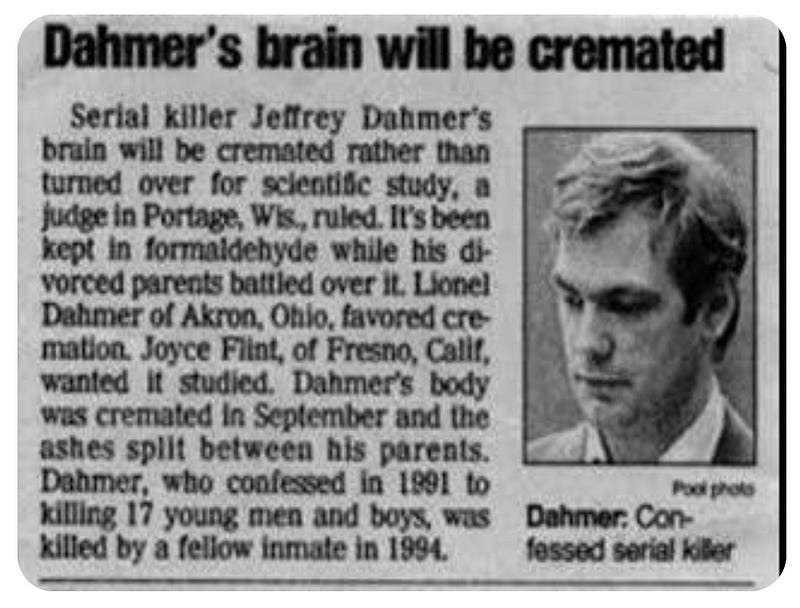Coping with Monsters: The Tragic Circumstances That Make People Commit Crimes
What Made Jeffrey Dahmer Kill and What Have Medium Writers Written about Him
What Made Jeffrey Dahmer Kill and What Have Medium Writers Written about Him
Between 1978 and 1991, Jeffrey Dahmer lured men to a place where he drugged, abused, murdered, and cannibalized them. Dahmer, like other serial killers, has captivated the world’s attention with his twisted, horrifying, and nightmarish crimes; and in 2022, with the streaming of the Netflix show, Monster: The Jeffrey Dahmer Story, his name and his crimes have resurfaced in mainstream media.The series rekindled “one of the oldest questions in the history of philosophy” concerning “the moral nature of Man” Dustin Arand : Are people good but corruptible or are they evil but restrainable? Rather than exploiting these tragedies for entertainment-profit, Heather Anderson Kokx argued that:
“It’s time to start thinking of serial killers more like disease, studied for a cure.”
In part 1 of Coping with Monsters we will explore the context that contributed to Dahmer’s monstrous actions.
The questions posed by Dustin and Heather must have bothered Dahmer’s parents so deeply that they went to court over whether to study Jeffrey’s brain or cremate it. Before Dahmer died, his father wrote a book which explored. what environmental factors were responsible for Dahmer’s horrendous acts. His mother, we suspect, thought that examining his brain would reveal that Dahmer became a killer regardless of his upbringing. The verdict was given and she lost. At his father’s request, Dahmer’s brain was cremated (December, 1995). Many writers, spurred by the success of Netflix’ show, have debated what made Dahmer kill. Identifying why some people murder implicitly suggests ways to stop them.

Ever since he was a child, Dahmer was subjected to parental neglect and abuse. True-crime writer, Dani Hendrix, wrote that Dahmer was seemingly a normal child up until the age of four, when he was subjected to a surgery for a double hernia after which his mood and demeanor changed. His parents were too involved in their own squabbles to notice that as a teenager Dahmer had few friends, abused alcohol, and started to develop dark fantasies. Netflix’s Dahmer emphasizes this neglect and shows a few dysfunctional interactions between him and his parents. The emphasis on this part of Dahmer’s life implies that he would have been normal if he had not been neglected or if others would have helped. However, another Medium writer points out how many people have faced difficult childhoods, even worse than Dahmer, but they have not turned into serial killers. Perhaps neglect is insufficient.
In addition to parental neglect; Dahmer further experienced highly unusual experiences as a child. Dahmer’s father questionably chose to teach young Jeffrey how to skin and dissect dead animals, presuming that the parent was cultivating an interest in science. It is this experience with roadkill, among others, which some associate with Dahmer’s compulsion to kill. During this time Dahmer learnt how to deal and dispose of animal bodies. Upon his arrest, the Associated Press reported that he developed a fascination for “body parts when, as a child he watched his father cut open a fish and he saw the bright orange egg sac inside. By age 16”- a psychiatrist said — “Dahmer was cutting open dead animals he found along the road, and by 18 he was plotting a murder.” This unusual childhood hobby could have developed into his obsession.
Netlflix’s Dahmer also emphasizes these experiences, hinting that they contributed toward making a killer from a shy boy. In the show, Evan Peters convincingly portrays Dahmer’s interest when dealing with meat, flesh, and viscera. In the second episode, “Please Don’t Go,” while working at the butchery, Dahmer is shown so immersed in grinding meat that he does not respond the first time his boss calls him. The manner in which these are portrayed implies that Dahmer’s interest in butchery resulted from his childhood experiences. The show omits. Dahmer’s beliefs.
Jonathan Poletti argued that Dahmer grew up as part of a vehemently homophobic church and that it was his Christian beliefs that drove him to target gay men. Poletti claimed that Dahmer rarely spoke about his childhood church and that he protected them to the very end. While in prison, Dahmer spent a lot of time with the chaplain (presumably from a different denomination). He asked and was baptized. The church’s chaplain thinks the conversion was genuine. For Dan Foster, who is a believer, Dahmer baptism raises the possibility that this “messed up dude” is in heaven. Notwithstanding, another Medium writer has posited that Dahmer was not really religious given that he had a Satanic bible. This author also suggests that not all churches were homophobic and hence Dahmer’s views cannot be linked to religious belief. The question is whether beliefs can influence how people act and if they drove Dahmer, regardless of their origins. Similarly, secular beliefs, habits, and assumptions could have also affected Dahmer.
Dahmer denied choosing his victims based on race or sexual orientation, instead, he claimed to simply feel attraction towards them. Regardless, most of them were people of color and/or homosexuals, suggesting that racism and homophobia likely exemplify influential factors. Dahmer may have chosen to target those who were less likely to be reported missing. Perhaps he killed gay men because they were gay. Racism and homophobia enabled Dahmer to keep killing. It has been argued that policemen ignored clear signs and were derelict of their duties because they made certain assumptions about Dahmer and his victims. In one instance Dahmer invited fourteen-year-old Konerak Sinthasomphone to his apartment to take some photos. Dahmer drugged, attacked, and performed a rudimentary lobotomy on Sinthasomphone. This operation was meant to turn him into a sex zombie (more on that in our blog). Sinthasomphone managed to escape. Concerned about this young man’s health, several neighbors called the police. Policemen showed up to investigate and returned the boy to Dahmer when he misled them, by saying that Sinthasomphone was his inebriated boyfriend. This appalling tragedy is portrayed in chapter two of Netflx’s series where the officers escort the child back to Dahmer’s apartment, and reluctantly inspect the room, out of fear of “catching something.” Clearly, the policemen’s beliefs about certain kinds of people delayed them from arresting Dahmer.
The Netflix series seems to suggest that Dahmer could have been good, but was corrupted by his surroundings and personal experiences. The factors discussed above and the series hint that if only someone would have helped him, then some of the incidents that led to his crimes could have been prevented. Another Medium writer, Emma, reflected (after watching the series) whether she would have become a monster too if she had not met people who helped her. Emma’s incredibly sympathetic perspective should encourage everybody to reflect about how their circumstances shape them. In part I we have examined how Medium writers have responded to Netflix’s Dahmer. These responses raise questions about how a segment of the population explains serial killers. We will soon publish Part II which explores other more deterministic explanations about what made Dahmer such a horrible human being.
Note: We had drawn from the work of other writers at Medium. We have endeavored to accurate represent other writer’s thoughts and opinions. Some cited articles discuss matters beyond those synthesized here. We remain open to adding changes, and notes, clarifying writers ideas and positions. At Curing Crime we are interested in exploring how crime is explained and thought it would be worthwhile to create a dialogue between different articles.
Authors: Lucas Heili and Christian Orlic
Update April 10 2023 — For part II click here
Originally published on Medium





